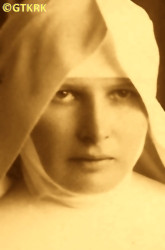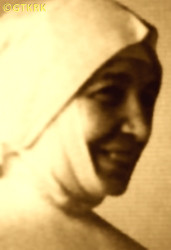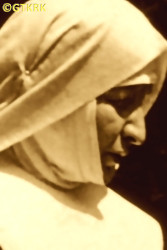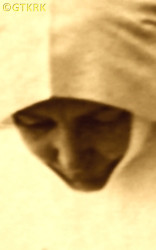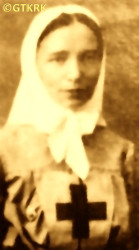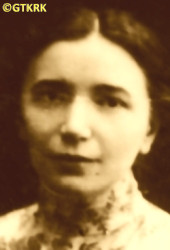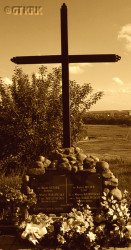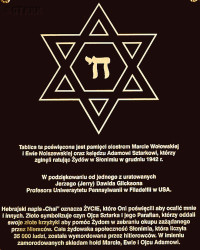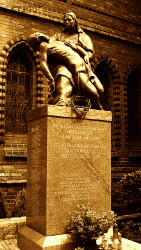Roman Catholic
St Sigismund parish
05-507 Słomczyn
85 Wiślana Str.
Konstancin deanery
Warsaw archdiocese, Poland
full list:
displayClick to display full list

searchClick to search full list by categories
wyświetlKliknij by wyświetlić pełną listę po polsku

szukajKliknij by przeszukać listę wg kategorii po polsku

Martyrology of the clergy — Poland
XX century (1914 – 1989)
personal data
religious status
blessed
surname
NOISZEWSKA
forename(s)
Bogumila (pl. Bogumiła)
religious forename(s)
Mary Eve of Providence (pl. Maria Ewa od Opatrzności)
beatification date
13.06.1999more on
www.swzygmunt.knc.pl
[access: 2013.05.19]

the RC Pope John Paul IImore on
en.wikipedia.org
[access: 2014.09.21]
function
nun
creed
Latin (Roman Catholic) Church RCmore on
en.wikipedia.org
[access: 2014.09.21]
congregation
Congregation of the Sisters of the Immaculate Conception of the Blessed Virgin Mary CSICmore on
en.wikipedia.org
[access: 2013.05.19]
(i.e. Sisters of the Immaculate Conception of the BVM)
date and place
of death
19.12.1942

Petralevichitoday: Petralevichi 1 and Petralevichi 2, Pavlovo ssov., Slonim dist., Grodno reg., Belarus
more on
be.wikipedia.org
[access: 2023.01.18]
details of death
After the German and Russian invasion of Poland in 09.1939 and start of World War II, after start of the Russian occupation, almost immediately evicted with her sisters from the main rooms of the monastery in Baranavichy, which the Russians turned into a children's hospital.
Moved to little rooms in the attic.
Forbidden to wear habits.
Hired however as a doctor in the hospital, together with a few other nuns who worked as laundresses or orderlies.
In 04.1940 fired from work and evicted from the rooms in the attic.
Moved initially to Wiszniew, next to Navahrudak, and finally to Lubcza where found a job as a medical doctor.
After the German attack on 22.06.1941 on her former ally, the Russians, and the start of the German occupation, returned in c. 08.1941 to Congregation's house in Baranavichy, where the Germans organized a military hospital, and became city doctor.
When the persecution of Jews began and a ghetto was established in Baranavichy, helped Jews, among others smuggling food.
Hid and gave shelter to the Jewish children in Baranavichy convent.
During the night of 18.12.1942 — after bloody liquidation of Baranavichy ghetto in 07.1942 — arrested by the Germans, together her superior from Baranavichy convent, Sr Casimira Wołoska, and Fr Adam Sztark, local Jesuit parish priest.
In the morning of the next day was murdered by Germans and Belarus police collaborating with them in a mass execution.
cause of death
mass murder
perpetrators
Germans / Belarusians
sites and events
Pietralewicka HillClick to display the description, Help to the JewsClick to display the description, Ribbentrop‐MolotovClick to display the description, Pius XI's encyclicalsClick to display the description
date and place
of birth
11.06.1885

Osanishkitoday: Opsa ssov., Braslaw dist., Vitebsk reg., Belarus
more on
be.wikipedia.org
[access: 2023.01.18]
parents
NOISZEWSKI Casimir Bronislav Louis
🞲 11.09.1859, Vilniustoday: Vilnius city dist., Vilnius Cou., Lithuania
more on
en.wikipedia.org
[access: 2022.01.06] — 🕆 05.07.1930, Warsawtoday: Warsaw city pov., Masovia voiv., Poland
more on
en.wikipedia.org
[access: 2021.10.09]

ANDRUSZKIEWICZ Mary Agnes
🞲 1866, ? — 🕆 1918, Warsawtoday: Warsaw city pov., Masovia voiv., Poland
more on
en.wikipedia.org
[access: 2021.10.09]
religious vows
12.05.1921 (temporary)
16.07.1927 (permanent)
positions held
1938 – 1942
nun — Slonimtoday: Slonim dist., Grodno reg., Belarus
more on
en.wikipedia.org
[access: 2021.09.29] ⋄ Congregation's house, Immaculate Conception Sisters CSIC — tutor and teacher in a gymnasium run by nuns, school doctor
1926 – 1938
nun — Yazlovetstoday: Buchach urban hrom., Chortkiv rai., Ternopil obl., Ukraine
more on
en.wikipedia.org
[access: 2020.11.15] ⋄ Congregation's house, Immaculate Conception Sisters CSIC — medical doctor and infirmary nurse
1930 – 1936
director — Yazlovetstoday: Buchach urban hrom., Chortkiv rai., Ternopil obl., Ukraine
more on
en.wikipedia.org
[access: 2020.11.15] ⋄ gymnasium – Economic Seminary
from 1933
certified teacher — chemistry and commodity science, household school
from 1928
certified teacher — natural sciences, general secondary schools and teacher training seminars, state and private
1924 – 1926
nun — Jarosławtoday: Jarosław gm., Jarosław pov., Subcarpathia voiv., Poland
more on
en.wikipedia.org
[access: 2021.04.01] ⋄ Congregation's house, Immaculate Conception Sisters CSIC — teacher and medical doctor
1921 – 1936
nun — Yazlovetstoday: Buchach urban hrom., Chortkiv rai., Ternopil obl., Ukraine
more on
en.wikipedia.org
[access: 2020.11.15] ⋄ Congregation's house, Immaculate Conception Sisters CSIC
from 12.05.1920
novitiate — Yazlovetstoday: Buchach urban hrom., Chortkiv rai., Ternopil obl., Ukraine
more on
en.wikipedia.org
[access: 2020.11.15] ⋄ Congregation's house, Immaculate Conception Sisters CSIC
1919 – 1920
postulate — Szymanówtoday: Teresin gm., Szymanów pov., Masovia voiv., Poland
more on
en.wikipedia.org
[access: 2021.03.16] ⋄ General House, Immaculate Conception Sisters CSIC
1918 – 1919
medical doctor — Warsawtoday: Warsaw city pov., Masovia voiv., Poland
more on
en.wikipedia.org
[access: 2021.10.09] ⋄ Helena Rzeszotarska's School for Girls (seven‐grade) — also: hygiene lecturer
c. 1914 – 1918
medical doctor — Kievtoday: Kiev city rai., Kiev city obl., Ukraine
more on
en.wikipedia.org
[access: 2023.03.02] ⋄ infectious diseases hospital
1903 – 1914
student — Sankt Petersburgtoday: Saint Petersburg city, Russia
more on
en.wikipedia.org
[access: 2020.07.31] ⋄ Medical Institute for Women — with brakes; Russian medical doctor's diploma, recognized in Poland in 1926
others related
in death
GROCHOWSKIClick to display biography Casimir, SZTARKClick to display biography Adam, WOŁOWSKAClick to display biography Casimira (Sr Mary Martha of Jesus)
sites and events
descriptions
Pietralewicka Hill: A small hill nearby Pietralewicze village by the Baranavichy town, place of German mass murders, mainly Jews, but also of local Polish intelligentsia. From 10,000 to 21, 000 victims might have been murdered there (or even as many as 42,000). (more on: kresowiacy.comClick to attempt to display webpage
[access: 2013.12.27], www.sztetl.org.plClick to attempt to display webpage
[access: 2013.12.27])
Help to the Jews: During World War II on the Polish occupied territories Germans forbid to give any support to the Jews under penalty of death. Hundreds of Polish priests and religious helped the Jews despite this official sanction. Many of them were caught and murdered.
Ribbentrop‐Molotov: Genocidal Russian‐German alliance pact between Russian leader Joseph Stalin and German leader Adolf Hitler signed on 23.08.1939 in Moscow by respective foreign ministers, Mr. Vyacheslav Molotov for Russia and Joachim von Ribbentrop for Germany. The pact sanctioned and was the direct cause of joint Russian and German invasion of Poland and the outbreak of the World War II in 09.1939. In a political sense, the pact was an attempt to restore the status quo ante before 1914, with one exception, namely the „commercial” exchange of the so‐called „Kingdom of Poland”, which in 1914 was part of the Russian Empire, fore Eastern Galicia (today's western Ukraine), in 1914 belonging to the Austro‐Hungarian Empire. Galicia, including Lviv, was to be taken over by the Russians, the „Kingdom of Poland” — under the name of the General Governorate — Germany. The resultant „war was one of the greatest calamities and dramas of humanity in history, for two atheistic and anti‐Christian ideologies — national and international socialism — rejected God and His fifth Decalogue commandment: Thou shall not kill!” (Abp Stanislav Gądecki, 01.09.2019). The decisions taken — backed up by the betrayal of the formal allies of Poland, France and Germany, which on 12.09.1939, at a joint conference in Abbeville, decided not to provide aid to attacked Poland and not to take military action against Germany (a clear breach of treaty obligations with Poland) — were on 28.09.1939 slightly altered and made more precise when a treaty on „German‐Russian boundaries and friendship” was agreed by the same murderous signatories. One of its findings was establishment of spheres of influence in Central and Eastern Europe and in consequence IV partition of Poland. In one of its secret annexes agreed, that: „the Signatories will not tolerate on its respective territories any Polish propaganda that affects the territory of the other Side. On their respective territories they will suppress all such propaganda and inform each other of the measures taken to accomplish it”. The agreements resulted in a series of meeting between two genocidal organization representing both sides — German Gestapo and Russian NKVD when coordination of efforts to exterminate Polish intelligentsia and Polish leading classes (in Germany called «Intelligenzaktion», in Russia took the form of Katyń massacres) where discussed. Resulted in deaths of hundreds of thousands of Polish intelligentsia, including thousands of priests presented here, and tens of millions of ordinary people,. The results of this Russian‐German pact lasted till 1989 and are still in evidence even today. (more on: en.wikipedia.orgClick to attempt to display webpage
[access: 2015.09.30])
Pius XI's encyclicals: Facing the creation of two totalitarian systems in Europe, which seemed to compete with each other, though there were more similarities than contradictions between them, Pope Pius XI issued in 03.1937 (within 5 days) two encyclicals. In the „Mit brennender Sorge” (Eng. „With Burning Concern”) published on 14.03.1938, condemned the national socialism prevailing in Germany. The Pope wrote: „Whoever, following the old Germanic‐pre‐Christian beliefs, puts various impersonal fate in the place of a personal God, denies the wisdom of God and Providence […], whoever exalts earthly values: race or nation, or state, or state system, representatives of state power or other fundamental values of human society, […] and makes them the highest standard of all values, including religious ones, and idolizes them, this one […] is far from true faith in God and from a worldview corresponding to such faith”. On 19.03.1937, published „Divini Redemptoris” (Eng. „Divine Redeemer”), in which criticized Russian communism, dialectical materialism and the class struggle theory. The Pope wrote: „Communism deprives man of freedom, and therefore the spiritual basis of all life norms. It deprives the human person of all his dignity and any moral support with which he could resist the onslaught of blind passions […] This is the new gospel that Bolshevik and godless communism preaches as a message of salvation and redemption of humanity”… Pius XI demanded that the established human law be subjected to the natural law of God , recommended the implementation of the ideal of a Christian state and society, and called on Catholics to resist. Two years later, National Socialist Germany and Communist Russia came together and started World War II. (more on: www.vatican.vaClick to attempt to display webpage
[access: 2023.05.28], www.vatican.vaClick to attempt to display webpage
[access: 2023.05.28])
sources
personal:
swzygmunt.knc.plClick to attempt to display webpage
[access: 2012.11.23], www.actamedicorum.ump.edu.plClick to attempt to display webpage
[access: 2020.09.24]
bibliographical:
„A martyrology of Polish clergy under German occupation, 1939‐1945”, Fr Szołdrski Vladislaus CSSR, Rome 1965
original images:
deon.plClick to attempt to display webpage
[access: 2020.09.24], www.salon24.plClick to attempt to display webpage
[access: 2020.09.24], www.actamedicorum.ump.edu.plClick to attempt to display webpage
[access: 2020.09.24], www.actamedicorum.ump.edu.plClick to attempt to display webpage
[access: 2020.09.24], www.niepokalanki.plClick to attempt to display webpage
[access: 2020.09.24], www.actamedicorum.ump.edu.plClick to attempt to display webpage
[access: 2020.09.24], www.apchor.plClick to attempt to display webpage
[access: 2020.09.24], www.flickr.comClick to attempt to display webpage
[access: 2014.01.06], www.flickr.comClick to attempt to display webpage
[access: 2014.01.06], www.niepokalanki.plClick to attempt to display webpage
[access: 2014.01.06], kslpmazowsze.plClick to attempt to display webpage
[access: 2020.09.24], www.szczecin.plClick to attempt to display webpage
[access: 2014.09.21]
LETTER to CUSTODIAN/ADMINISTRATOR
If you have an Email client on your communicator/computer — such as Mozilla Thunderbird, Windows Mail or Microsoft Outlook, described at WikipediaPatrz:
en.wikipedia.org, among others — try the link below, please:
LETTER to CUSTODIAN/ADMINISTRATORClick and try to call your own Email client
If however you do not run such a client or the above link is not active please send an email to the Custodian/Administrator using your account — in your customary email/correspondence engine — at the following address:

giving the following as the subject:
MARTYROLOGY: NOISZEWSKA Bogumila
To return to the biography press below:
 Click to return to biography
Click to return to biography








